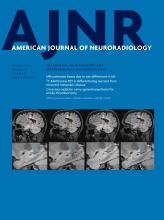Review ArticleAdult Brain
Open Access
Dentate Update: Imaging Features of Entities That Affect the Dentate Nucleus
K.M. Bond, W. Brinjikji, L.J. Eckel, D.F. Kallmes, R.J. McDonald and C.M. Carr
American Journal of Neuroradiology August 2017, 38 (8) 1467-1474; DOI: https://doi.org/10.3174/ajnr.A5138
K.M. Bond
aFrom Mayo Clinic School of Medicine (K.M.B.)
W. Brinjikji
bthe Department of Radiology (W.B., L.J.E., D.F.K., R.J.M., C.M.C.), Mayo Clinic, Rochester, Minnesota.
L.J. Eckel
bthe Department of Radiology (W.B., L.J.E., D.F.K., R.J.M., C.M.C.), Mayo Clinic, Rochester, Minnesota.
D.F. Kallmes
bthe Department of Radiology (W.B., L.J.E., D.F.K., R.J.M., C.M.C.), Mayo Clinic, Rochester, Minnesota.
R.J. McDonald
bthe Department of Radiology (W.B., L.J.E., D.F.K., R.J.M., C.M.C.), Mayo Clinic, Rochester, Minnesota.
C.M. Carr
bthe Department of Radiology (W.B., L.J.E., D.F.K., R.J.M., C.M.C.), Mayo Clinic, Rochester, Minnesota.

REFERENCES
- 1.↵
- 2.↵
- 3.↵
- 4.↵
- Schmahmann JD,
- Sherman JC
- 5.↵
- Timmann D,
- Drepper J,
- Frings M, et al
- 6.↵
- Salamon N,
- Sicotte N,
- Drain A, et al
- 7.↵
- Suzuki L,
- Coulon P,
- Sabel-Goedknegt EH, et al
- 8.↵
- Hoover JE,
- Strick PL
- 9.↵
- Guillan G,
- Mollaret P
- 10.↵
- Murdoch S,
- Shah P,
- Jampana R
- 11.↵
- Shaikh AG,
- Hong S,
- Liao K, et al
- 12.↵
- Wakai S,
- Nagai M
- 13.↵
- 14.↵
- Fazekas F,
- Kleinert R,
- Roob G, et al
- 15.↵
- Frytak S,
- Moertel CH,
- Childs DS
- 16.↵
- 17.↵
- Horlen CK,
- Seifert CF,
- Malouf CS
- 18.↵
- Woodruff BK,
- Wijdicks EF,
- Marshall WF
- 19.↵
- White GW,
- Gibby WA,
- Tweedle MF
- 20.↵
- Kanda T,
- Ishii K,
- Kawaguchi H, et al
- 21.↵
- 22.↵
- 23.↵
- 24.↵
- 25.↵
- Noseworthy JH,
- Lucchinetti C,
- Rodriguez M, et al
- 26.↵
- Anderson VM,
- Fisniku LK,
- Altmann DR, et al
- 27.↵
- Fisher E,
- Lee JC,
- Nakamura K, et al
- 28.↵
- Gilmore CP,
- Geurts JJ,
- Evangelou N, et al
- 29.↵
- Du SL,
- Sah SK,
- Zeng C, et al
- 30.↵
- 31.↵
- Tjoa CW,
- Benedict RH,
- Weinstock-Guttman B, et al
- 32.↵
- 33.↵
- 34.↵
- 35.↵
- 36.↵
- 37.↵
- Avrahami E,
- Cohn DF,
- Feibel M, et al
- 38.↵
- Elshimali Y
- 39.↵
- Govindarajan A
- 40.↵
- Kobari M,
- Nogawa S,
- Sugimoto Y, et al
- 41.↵
- Castro-Gago M,
- Blanco-Barca MO,
- Campos-González Y, et al
- 42.↵
- Zhu ZQ,
- Yao JB,
- Johns T, et al
- 43.↵
- Lee HF,
- Tsai CR,
- Chi CS, et al
- 44.↵
- Finsterer J
- 45.↵
- Arii J,
- Tanabe Y
- 46.↵
- 47.↵
- Pandolfo M
- 48.↵
- 49.↵
- Mascalchi M,
- Salvi F,
- Piacentini S, et al
- 50.↵
- Koeppen AH,
- Michael SC,
- Knutson MD, et al
- 51.↵
- 52.↵
- 53.↵
- 54.↵
- 55.↵
- Kronn D,
- Oddoux C,
- Phillips J, et al
- 56.↵
- Matalon R,
- Michals K,
- Sebesta D, et al
- 57.↵
- Namboodiri AM,
- Peethambaran A,
- Mathew R, et al
- 58.↵
- Brismar J,
- Brismar G,
- Gascon G, et al
- 59.↵
- 60.↵
- McAdams HP,
- Geyer CA,
- Done SL, et al
- 61.↵
- Wittsack HJ,
- Kugel H,
- Roth B, et al
- 62.↵
- Lindner M,
- Kölker S,
- Schulze A, et al
- 63.↵
- 64.↵
- 65.↵
- Brismar J,
- Ozand PT
- 66.↵
- 67.↵
- Harper PA,
- Healy PJ,
- Dennis JA
- 68.↵
- Brismar J,
- Aqeel A,
- Brismar G, et al
- 69.↵
- Gupta AK,
- Chowdhury V,
- Khandelwal N
In this issue
American Journal of Neuroradiology
Vol. 38, Issue 8
1 Aug 2017
Advertisement
K.M. Bond, W. Brinjikji, L.J. Eckel, D.F. Kallmes, R.J. McDonald, C.M. Carr
Dentate Update: Imaging Features of Entities That Affect the Dentate Nucleus
American Journal of Neuroradiology Aug 2017, 38 (8) 1467-1474; DOI: 10.3174/ajnr.A5138
0 Responses
Jump to section
Related Articles
Cited By...
- Structural covariation between cerebellum and cerebral cortex is atypically modulated by thalamus in autism spectrum disorder
- Effects of Gadolinium Depositions in Vivo
- Gadolinium Retention in the Brain: An MRI Relaxometry Study of Linear and Macrocyclic Gadolinium-Based Contrast Agents in Multiple Sclerosis
- Novel genotype-phenotype and MRI correlations in a large cohort of patients with SPG7 mutations
- Reversible cerebellar neurotoxicity induced by metronidazole
This article has not yet been cited by articles in journals that are participating in Crossref Cited-by Linking.
More in this TOC Section
Similar Articles
Advertisement











